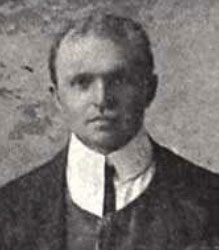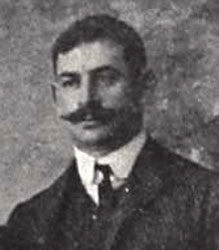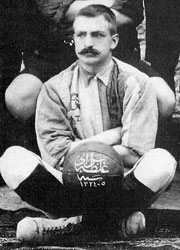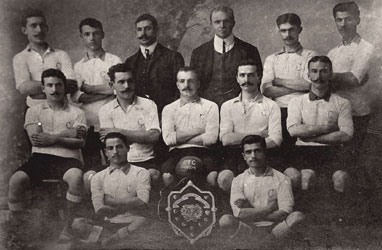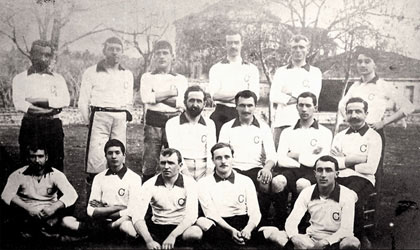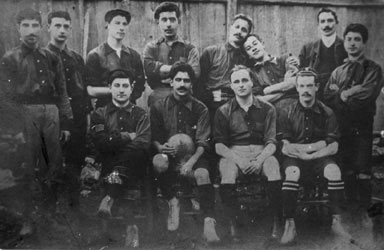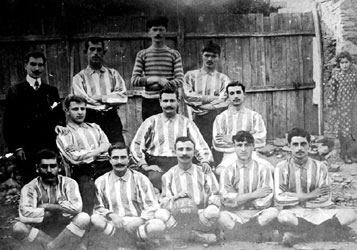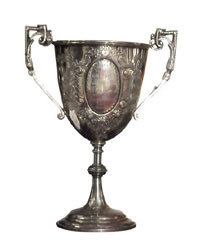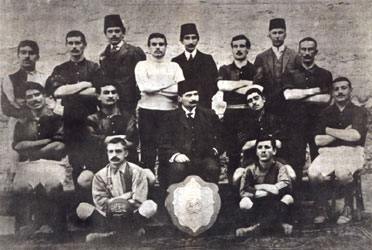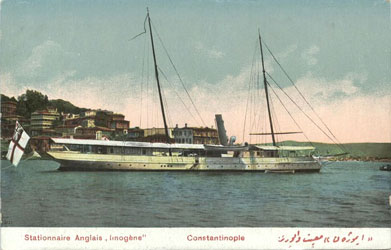Introduction
My reserch is concentrated on the story of the football league championship that took place between 1904 and 1915 organized amongst the Levantines of Constantinople / Istanbul, the capital of the Ottoman Empire, the victor receiving a special cup brought from Britain for this purpose. This research took many months and I hope it will provide new insights into the beginnings of football in Turkey and help inspire the lovers of the sport for generations to come.
Levantines with a love of football
If we want to focus on the first players who decided to organize a regular football league in Constantinople, then the two names that are revealed in the archives are the sons of two established Levantine families of the city, James La Fontaine1 and his close friend Henry Pears2. Football spread rapidly in popularity amongst the minorities of Constantinople and these two young Levantines decided to create a football league in a similar way as was being organized in their home countries. To this dynamic duo another Levantine Horace Armitage3 later joined in the effort and this individual later became the captain and technical director of the Galatasaray team, an illustrious squad still prominent today. James La Fontaine was also a good organizer and ordered from Britain a shield consisting of 10 silver plates arranged in a heart pattern on a mahagony base4. In the various sources dealing with the football history of Turkey there is much confusion as to the date of order of this shield and who financed it. Some sources claim that the cost was borne by the players who each had to pay 25 kuruş and the shield was brought to Turkey within the first season of the Istanbul league. However from the archives in the Galatasaray Club we are informed that the first year football league games were not included in this shield through the written explanation to the club management committee by the founder Ali Sami (Yen) on 29 Teşrinisani 1336 (29 November 1920). The same piece of document also illuminates the purchase of the shield as Ali Sami Bey explains:
|
|
|
In 1321-1322 (1905-1906) a joint shield for the teams of Kadıköy, Moda, Imogene and Elpis was proposed. This was financed by Mr. James La Fontaine, Mr. Pears and in part by Mr. Yani Vasilyadi.5
Mr. Vasilyadi mentioned by Ali Sami Bey is amongst the founders of the Kadıköy [neighbourhood of Istanbul on the Asiatic shore - archive views] Club, to be mentioned in detail futher down. According to the rules laid out by these first football teams of Turkey, the league would run for 10 years and at the end of each season's play, the champion team would have its name engraved on the heart shaped silver shield retain the object for a year and at the end of the 10 year run, whichever team had the most championship wins would take away the shield forever to display in their trophy cabinet6. Also according to the early regulations, the winning team for the year would in addition receive a cup. The first organised football league history is detailed below:
H.M.S. Imogene (1904 1905, First Season)
The initial formal association was the Constantinople Association Football League established in 1902 by James La Fontaine and Henry Pears, encompasing a range of British and Greek clubs of the city. These individuals were also involved in the setting up in 1899 of the Cadi Keuy Football Club and on the upper portions of the plain white tops the letter C was sewn. Another British Club of the time, first mentioned in the archives in 1897 was the Moda Football Club whose top colours were red and blue. Elpis Football Club was established in 1904 by the members of the Greek community of Constantinople and whose top colours were blue and white (in Greek mythology, Elpis was the personification and spirit of hope (hope was usually seen as an extension to suffering by the Greek, not as a good), perhaps a child of Nyx and mother of Pheme, the goddess of fame, renown and rumour). In addition there was a British football team that took the name of the Ambassadorial yacht that was mostly in long-term anchor in Therapia (Tarabya), H.M.S. Imogene Football Club , composed of its crew and officers, first appearing in the records in 1898 when they were beaten 5-0 in a rugby match against the visiting British ship H.M.S. Nymphe. H.M.S. Imogene Football Club colours were dark blue and white. The champions for the 1904/5 season were Imogene and this is confirmed with a number of records, including the memoirs of Ali Sami Bey, one of the first major future Turkish players, whose initial interest and representation in these clubs was almost nill.
The records state that the second year of this league, the champions were Moda, the third year Kadıköy [Cadi Keuy] that now included in its ranks the first Turkish football player Bobby Fuad Hüsnü (Kayacan) and the following year the winners were Greek team Elpis. The league season began in the autumn and it appears to have finished in January / February. However all records agree that the founders of this league being the Constantinople Football Association in 1904-1905.
|
|
The first silver shield belongs to the Kadikeuy Football Association Club (1905-06 - the first season of the shield)
Following the first season which acted as an initial trial, this season is represented by the rivalry of four clubs. To avoid future confusion we will consider this season to the first one and subsequent ones will be numbered henceforth from there.
We have more information on this season than the initial trial one, played in 1905-1906 and whose victor would be engraved on the silver shield. Although we do not know the football results and dates, we know the score table. This table demonstrates to us that the league this time was played in two legs, that there was a change in the champion, and with the advantage of the founders of the league, Horace Armitage and James La Fontaine and Fuad Hüsnü (Karacan) being in their ranks, the Kadikeuy team which had finished third in the earlier season, defeated Imogene, the earlier champion, Moda was third and Elpis losing all matches was bottom of the table.
Since Kadikeuy and Imogene finished the league with equal number of points they played a pair of play-off matches, the first ending in a draw and in the second Kadikeuy wins the match by 2-0 on 1st March 1906 played in a place called Priests garden field and won the right to have its name inscribed in the first section of the silver shield set in mahagony. Our research confirms that as in the earlier league the matches were played in Kadikeuy (Priests field) [Papazın Çayırı] and Moda (Yoghurt Spring) [Yoğurt Çesme] and the season started in the November of 1905 and finished in March 1906.
While the 1905-1906 Istanbul league season was on, no doubt the Mekteb-i Sultani [Sultans School = later Galatasaray Lycée] in the middle of Pera was a centre of excitement. If we had a time machine now and flew back to the time and place where the Constantinople league played, no doubt amongst the spectators would be students from the afore-mentioned school including, the Yanya born Albanian background Turkish lexicographer, author, poet and reporter Ali Sami (Yen), son of Sami Frashëri (Şemsettin Sami), Emin Bülend (Serdaroğlu) and Asım Tevfik (Sonumut). One can almost imagine these friends would do a critique of the match and would be acquainted with Mr James La Fontaine who would politely but firmly tell the crowd go back, go back on the line! Even the dream is a delight to behold.
The irony is this eminent dictionary scientist died in 1904, well before his son would name a stadium in his honour having established a successful club on his own accord.
By watching these matches again and again Ali Sami developed a passion for the sport, yet despite going through hard times following losing his father a year and half earlier, being forced to leave as a family their mansion in Cadde Bostan through straightened circumstances, decided in a morning of October 1905 to establish a football team with a few friends. The aim as supported by their literature teacher, Mehmet Ata, was to play as a group like the British, to be a part of a team colour and name and win against non-Turkish teams.7
|
|
|
Kadikeuy again (1906-1907 - the second season of the shield)
At the time the Galatasaray club was founded, the Istanbul league had finished its first season and the 1906 season had just started. The league matches were played in the Priests field in Kuşdili and Yoğurt Çesme in Moda. The season started with the participation of the earlier four teams and despite Ali Sami Bey submitting his written request a month in, the head of the Istanbul league James La Fontaine accepted the admission of this new team.
As seen in the fixture published in the newspaper Levant Herald whose main readership were the English Levantines, the 1906-1907 season Istanbul league was again played in 2 halves. Kadikeuy once again became champions and got their name inscribed again on the shield. However since we do not have the score-board we do not know the relative positions of the other teams. However we know that another team making its appearance for the first time was the Balta Liman AFC whose players were Istanbul Greeks. Sources on football history state the final match of the league, being between Galatasaray and Elpis was not played due to Galatasaray going to Izmir, but we were not able to find any documentation to prove this trip ever happened. However from the league fixture we were able to prove the Elpis match being the final one of the season. The first official match played by Galatasaray was the one played against Imogene on 25 November 1906 in which they scored their first goal. In this match both sides scored one goal, and the Galatasaray goal was scored by the ethnic Bulgarian student of Mektebi-i Sultani, Boris Nikolof, the first score in the clubs history.8 The first official defeat of Galatasaray occured on Sunday 9 December 1906 playing against Balta Limanı on their pitch. This game was reported by Ali Sami Bey published in the İdman Mecmua [Training Magazine] in 1913 under the appraisal of matches played in 1906 and compared with the publication years fixture where Balta Limanı also featured. As Balta Limanı hadnt played again against this team until 1913 it is likely the defeat of Galatasaray by 5-0 at this earlier date was a league match.
The first entrapment of the shield (1907-1908, the third season)
The third season of the now maturing Istanbul league was to see a higher degree of rivalry and Moda which was runner-up in the earlier season became the champions for the first and only time. In this 1907-1908 season Kadikeuy came second and both Balta Liman and Imogene had by this stage withdrawn from the league, their places being taken by the students of the American College with the team having the same name: Robert College and a new team composed of Greek community members wearing blue and white jerseys and calling themselves by the English name of Strugglers. Unfortunately we have no verified information on where Galatasaray finished this season.
The season was once again played in 2 halves in the various fields around Istanbul and Galatasaray was able to achieve its first formal win. Relations between this seasons champions Moda and Kadikeuy, a club that had lost its international flavour and was now populated by Greeks, had reached a low ebb to such an extent that Kadikeuy refused to hand over the shield, so Moda couldnt inscribe its name on the third heart segment. This was the first, but as we shall see later, not the last dispute arising over the non-handover of a possessive club to the new victor.
In this season as well Kadikeuy and Moda finished the league with equal number of points and play a pair of play-off matches to decide the champion. Moda out-classes its opponent in the first match and wins and in the second meeting while the game was set 1 all, as a result of a goal being disqualified by the referee, Kadikeuy supporters invade the pitch and their team withdraws. The referee calls the match off and fans of football in Istanbul await with interest the decision the Football Association would give. Finally the Association decides Moda that won the first match would be the champion. In reality these Kadikeuy-Moda fixtures were the first derbys of Istanbul and not the later Galatasaray-Fenerbahçe matches. These Kadikeuy-Moda matches were termed big matches by the local press of the time such as Monitor Dorient.
|
|
The Galatasaray masters (1908-1909, the fourth shield season)
The fourth season of the league was a turning point for Turkish football. The season starts a few months after the Second Reform Edict [II. Meşrutiyet] and for the first time a Turkish team wins against all opponents to be champion. In addition Kadikeuy that was still holding on to the shield softens its attitude. With that the third heart receives the inscription of Moda and the fourth segment gets the name of Galatasaray inscribed on it.
For the details of this history, lets refer to the writings of Ali Sami:
Despite the fact that Moda won the 1907-1908 season, Kadıköy did not part with the shield. In the Autumn-Winter season of 1908-1909 Galatasaray won the cup and was able to get the shield from Kadıköy and was able to have inscribed on it its own name as well as that of Moda.
We do not know how Galatasaray was able to convince the obstinate Kadıköy to release the shield. What is striking is that Galatasaray to its credit ensured the name of the deserving Moda was inscribed on the shield before its own.
Before the start of the 1908-1909 season Galatasaray strengthened its position by adding to its team from Kadıköy the talents of Fuad Hüsnü Kayacan and the founder of the league, Horace Armitage. Before the season started, in a promise to Ali Sami, Horace Armitage stated: As a group of ten Turks and one Englishman we will against all other teams and become champions and with his leadership and management this is indeed what did happen. This was also the first championship victory of any Turkish team. Elpis which finished last in the earlier season did not take part in the 1908-1909 season, while last years champion Moda came second, Imogene third and the bottom place was taken by the former twice champion, but increasingly weakening Kadıköy. The Fenerbahçe club was newly established and as it was not accepted into the league as it was considered too weak for the standard established. The matches were still played mostly in the Union Club pitch and the various fields on the Anatolian side of the Bosphorus (Küçüksu, Beykoz, Haydarpaşa). The first match played by Fenerbahçe was outside the league but on the Union Club pitch on Sunday 17th January 1909, forming the seed for the still on-going rivalry. Galatasaray won the match with two goals scored by Emin Bülend against its rival without conceding any goals9. Thus Emin Bülend became first Galatasaray team member to score a goal against Fenerbahçe. Eventhough some sources refer to these special matches as neighbourhood matches they were nevertheless matches whose details were recorded and thus are part of these teams histories.
The Galatasaray-Kadıköy match played out in the 1908-1909 Istanbul league has a special importance. The Union Club brings forth a Union Club Cup and so the victor would also obtain this trophy. Played on Sunday 31st January 1909, Galatasaray scores four goals, concedes none, and so obtains revenge for its earlier heavy defeat. In this manner this cup becomes the first obtained by Galatasaray and a Turkish team. The cup still greets visitors at the Galatasaray Museum, still noble after its 100 years of display.
In addition in the league Galatasaray wins against Imogene with the huge margin of 11-0 and thus became the envy of other teams10. This champion teams captain and technical director was Horace Armitage.
Friendship in a foreign land (1909-1910, 5th Season of the Shield)
The fifth season had a special meaning. Now there were not one but two Turkish teams competing in the league. Fenerbahçe founded in 1908 was now seasoned enough to play in the league. Ali Sami Bey explains the foundation of the Fenerbahçe Club thus:
These are the circumstances under which I heard that the Fenerbahçe Club was to be formed. While matches were played, the balls that ended up beyond our pitch were kicked-back in by a slim, well-behaved youngster who caught my attention and when I asked his name, he answered it was Galip (Kulaksızoğlu)11. When I told him he could train in the Galatasaray shirt tears welled in his eyes through joy. However, later on, the same Galip came to me and said,
Ali Sami Bey, my friends are going to establish a team by the name of Fenerbahçe and I want to transfer there. If you dont allow me to do that I will abandon football and pursue another sport.
I told him not to leave football and the establishment of Fenerbahçe would also be good for Galatasaray. To see Fenerbahçe in my land full of foreign and non-Moslem teams would be like meeting a friend in a foreign land.12
Elpis that didnt compete in the previous season retuned to the league while Imogene that took part in all 5 seasons, including the trial of the league, quietly withdrew. Galatasaray which had strengthened its side, easily won this seasons league, however Ali Sami had to retire early from football owing to a broken foot received in a Kadıköy match. The team added its name to the 5th heart on the shield with pride.
The Struggles which participated in this season with quite a strong team nevertheless lost against Galatasaray but won against all other competition so finishing second. Moda was the third in the 1909-1910 season while Kadıköy was fourth. Elpis was able to overcome Fenerbahçe which was experiencing its first league experience. This season was also the first one in which Galatasaray and Fenerbahçe faced each other officially. The match played on Sunday 9th January 1910 on the pitch of the Union Club was decided by the goals scored by Celal İbrahim, Fuad Hüsnü Karacan and Horace Armitage.13 The early archives of the Galatasaray Museum records that the first goal scorer against Fenerbahçe was Celal İbrahim. As a result of James La Fontaines initiative a secondary league is established for the 1909-1910 season in which the reserve team of Galatasaray [later period team photos] wins the championship. The secretary of the Galatasaray reserve team Raşit Bey, records this cup success in an interesting way.14
Seven goals with seven players (1910 - 1911, VIth Season of the Shield)
Galatasaray became the champion once again on this the 6th season of the league, making it 3 on the trot and setting the pattern for the future as the most successful and effectively becoming the mother team with this exemplary success. The 1910-11 season in one crowned with many records that were broken. Not only was it the first time for a team to become champions three times successively, but it was also significant in terms of the now heated rivalry between Galatasaray and Fenerbahçe. Kadıköy, Strugglers ve Fenerbahçe all competed in this season, while Moda and Elpis were not participants. A group that had parted ways from Galatasaray competed under the name of Progress International, but Galatasaray still won all the matches to become champion.
On the day Fenerbahçe was to play there was a severe gale. Thus cross-Bosphorus sea traffic had virtually ceased, only 6 of the Galatasaray players could arrive by the start of the match. Another team member arrives 10 minutes into the game. On this day of Sunday 12th February 1911 in this match played in Kadıköy, Galatasaray with its seven players scores seven goals without conceding a single one. The star of the match was one of the founder members of the team, Celal İbrahim, who scores four goals. Emin Bülend who was the seventh man to join scored two and the remaining goal scorer was İdris Bey.9 Another interesting aspect of this match was the fact that the Fenerbahçe goalie Ali Said having to be replaced as he suffered an injury in the middle of the first half of the game and Fenerbahçe playing a new goalie after each goal was scored against them. The Progress team won against Fenerbahçe with five goals, placing it second in the league, while Kadıköy was third, Strugglers fourth and Fenerbahçe came last. Thus the Istanbul League in a now repeating fashion crowns Galatasaray with another cup. This century old cup can be seen in its glory in its walnut display cabinet at the Galatasaray Museum.
The Shield is with Fenerbahçe (1911-1912, VIIth Season of the Shield)
The closure of the Imogene, Moda and Elpis Clubs placed the league in a difficult situation. The management of the Istanbul Football Union which had been in the hands of Englishmen was now in the hands of the managers of Galatasaray, Kadıköy, Strugglers and Fenerbahçe. The participation of Galatasaray with a double team in the earlier season caused annoyance, particularly of Fenerbahçe. For this reason Fenerbahce obtaining the support of the new team Rumblers, established by the former players of Elpis and Moda, ensured the enactments of two provisions in the constitution of the league. According to the new provisions a club couldnt participate with two teams and the Galatasaray player, Adnan İbrahim (Piroğlu) who was deemed to have played in all matches in a harsh and undisciplined manner was banned from playing for a year. As expected Galatasaray didnt accept these new conditions. When all the efforts of the Galatasaray manager, Yusuf Ziya Öniş, to reverse these rules come to nothing, Galatasaray as a protest refuses to participate in the 8th season of the league.13 In reality there is some controversy concerning this non-participation, who was protesting who or boycotting who? Ali Sami Bey, in his written submission to the Galatasaray executive committee in connection with the shield, doesnt support the hypothesis:
...in the season of 1327-28 (1911-12) the league formed of Fenerbahçe, Rovers (Rumblers), Strugglers, Progress and Kadıköy, despite being champions earlier didnt accept Galatasaray in their ranks... and in this grouping Fenerbahçe became the judge...
With the withdrawal or non-participation of Galatasaray in the league, only two Turkish teams compete in the Istanbul league, these being Fenerbahçe and Progress. The league is thus formed of Kadıköy, that has competed since the inception of the league, Strugglers and the new Greek team of Rumblers. With the end of the 1911-12 season, as a result of the non-competition by Galatasaray, Fenerbahçe becomes champion without conceding any goals. Second place was taken by the new team, Rumblers, third place by the other Greek team, Strugglers, fourth place by Progress. Kadıköy finishes bottom of the league table. Fenerbahçe through being champions wish to add their name to the shield, however the shield has been in the possession of Galatasaray for the past three years; the story is elaborated by Ali Sami Bey again:
...With that Galatasaray invited the Fenerbahçe Club and explained on the match of April 328 (equating to the 16 April 1912 Galatasaray - Fenerbahçe match) they had been defeated by a margin of zero. This teams members were in favour of not relinquishing the shield. They argued the ownership now rested with the Galatasaray Club that had inscribed its name on it three times and that Fenerbahçe had no grounds to announce they were champions or have the right to have their name added to the shield. With that I consulted James La Fontaine. And I enquired about the existing statutes concerning the shields ownerships in such circumstances. He explained the shield would be kept secure in a public space or be given to the team that had inscribed their name most or to the team who had one 3 seasons consecutively. The unfortunate consequence is that in drafting the rules we hadnt made clear on these distinctions. Remedying this shortcoming is now necessary for this association. His suggestion was that the outcome of the shield placement should be decided by the Istanbul Football Association committee. With that I returned the shield to the board and writing a letter stated that the process pursued against Galatasaray was not fair and that having defeated the team wrongly declared champions, they couldnt relinquish the cup having won it 3 years in a row. The board rejected my arguments.
With this the shield passes on to Fenerbahçe. Ali Sami despite defending till the limit the club whose head he was, couldnt prevent the boards decision regarding Fenerbahçes rights. Fenerbahçe was thus able to add its name to the 7th segment of the shield.
Balkan War (1912-1913, Shields VIIIth Season)
1912 is a black year for the Ottoman Empire. On 8th May 1912 the Balkan War erupts, almost all the players in the football clubs are called to the military. Under these conditions only a few matches were played and the season was never completed. Amongst the archives we learn that Galatasaray and Kadıköy finish a match on a nil-nil draw. The interesting thing is Fenerbahçe despite not playing in the league games was able to inscribe its name for the second time on the shield. We couldnt come across any source that would explain how Fenerbahçe was able to add its name on to the 8th segment of the silver shield. I will deal with this and other mysteries in more detail at the end of my article.
First goal... (1913-1914, Shields IXth Season)
With the end of the war the clubs are able to organise themselves again, and while Kadıköy gives a break in its participation of the league, the team taking their place was formed of English technicians and workers employed at the Istanbul telephone system, with the name of Kampana Club, sporting the blue and white jersey. Galatasaray was weakened having sent a lot of its players to the war, but still participated. The league was played in two halves and in the latter stage Progress changed their name to Altınordu (Golden horde). In the games played on the Union Club pitch Fenerbahçe won against its perpetual rival Galatasaray with a 4-2 score, thus becoming champions for the second time, Altınordu came second end of season followed by Rumblers and Galatasaray came fourth, Strugglers fifth and bottom came Kampana which hadnt competed in the second half of the league matches. Fenerbahçe was thus able to add its name to another of the silver shield segments, as elaborated by Ali Sami Bey:
In the season of 1329-30 (1913-4) Fenerbahçe was for the first time able to win in a deserved manner. The fact that the first goal it scored against Galatasaray Club was on 4th January 1914, bringing clarity concerning its earlier championship.
The final heart (1914-1915, Shields Xth Season)
With the winding up of English and Greek teams in succession the field was now left to Turkish teams. The emerging new teams all wanted to join the league. However to avoid the strength imbalance, the relatively stronger teams organised a league amongst themselves. The new league called Istanbul Football Union League comprised Galatasaray, Fenerbahçe, Altınordu, Anadolu and Anadolu İdman Yurdu, acting as the continuation of the earlier nine seasons. Although Fenerbahçe was in the Union, initially it didnt participate in the league. However when it became stronger with transfers from Altınordu, it wished to join the league. However since the league year had already started this wish was refused.15 Again Ali Sami Bey explains this situation in greater detail:
By the 1330-31 (1914-15) season Galatasaray had gained considerable strength and Fenerbahçe through having some of its players elsewhere was in a weakened state. In that year the strongest Turkish teams playing in the Friday (a form of second division played by the weaker teams) and Sunday leagues came together, comprising Galatasaray, Fenerbahçe, Anadolu, İdman Yurdu and Altınordu. In the first instance Fenerbahçe with a polite language announced its withdrawal, stating they were too weak to compete. The Union tried to dissuade them from this decision unsuccessfully and together they decided to bring in Süleymaniye Club instead. This is the proof that Fenerbahçe was unwilling to participate. Once the games started Fenerbahçe requested to be let back in, but with conditions, relayed through their manager Fuat Bey. The Clubs requested approaches should be done through the correct channels and that the renewals shouldnt be done in an informal manner and despite repeated requests rejected Feners request.
In this season that Fenerbahçe didnt compete Galatasaray and Anadolu finished with the same number of points. Since the averages system was not known in those days, a final play-off between these two teams is decided to determine the champion. The match played on 3 April 1915 Saturday end with Galatasaray winning 3-2, thus being crowned champions. With that Anadolu come second, Anadoluhisarı İdman Yurdu third, Altınordu fourth and Süleymaniye last.
Istanbul Football Championship League (1914-1915)
As Fenerbahçe was not able to compete in the Istanbul Football League, it then joins the weaker Istanbul Football Championship League in which the teams of Türk İdman Ocağı, Darüşşafaka, Hilâl ve Darülmuallimin competed. Fenerbahçe easily wins all the matches in plays and finishes champion of this league. Türk İdman Ocağı comes second, Darüşşafaka third, Hilâl finishes fourth with Darülmuallimin with a single even score comes last.16
Two champions for one city
With the end of the season, there is a unique situation in Turkish football history, with two champions emerging in that season. Galatasaray argued that the league it played in was the continuation of the original Istanbul league and so the champion of that league should be considered the champion of Istanbul. These are the words of the late Ali Sami Bey on this issue referring to the first win of Fenerbahçe:
1 James La Fontaine should be b. 1881, m. 1904 Clara Keyser, d. 1933, son of Edward Augustus John La Fontaine and Blanche Magdalen Whittall. There are living descendants.
2 Henry Harry Pears was the son of Sir Edwin Pears, Solicitor, Constantinople. Harry - image - married Gertrude Anna Whittall and has descendants.
3 Horace Armitage was an English merchant in Constantinople and was also instrumental in the establishment of another famous team surviving till today, Fenerbahçe and was a player in both teams. He left Turkey for England in 1932 and died there in 1939. His grand-daughter Julie Taylor and great-granddaughter Sacha Robinson visited the Fenerbahçe team museum in Istanbul in September 2007 to be informed of the achievements of their ancestor.
4 Taken from the interview with Emin Bülend Serdaroğlu. Oral, M. Ali; Türkiye Futbol Tarihi [Turkish Football history] 1890-1912, Sulhi Garan Matbaası, 1954.
5 Taken from the translation of the original document penned by Ali Sami Yen to the Galatasaray Terbiyeyi Bedeniye [physical sports] Club, concerning the issue of the shield, 29 Teşrinisani 1336, held at the Galatasaray museum.
6 A brief explanation of the status of the Istanbul Sunday League. Arıpınar, Erdoğan and team; Türkiye Futbol Tarihi [Turkish Football history] 1904-1991 1st edition, Türkiye Futbol Futbol Federasyonu, 1992.
7 Segment of a long interview with Ali Sami Yen. Galatasaray Sports Club 50th anniversary almanac, Doğan Kardeş Yayınları, 1955.
8 The information of the goal scorer of the Imogene match obtained from a web site: Ertuğrul, Cem; The Development of Football in Turkey, www.ntvmsnbc.com article series, 2006.
9 Obtained from the statistics of the Galatasaray-Fenerbahçe derby matches. Pekin, Cem; Galatasaray-Fenerbahçe derby match notes, 2009.
10 Information obtained from the section 1908-1909 season, Arıpınar, Erdoğan and team; Turkish Football History 1904-1991, volume I, Turkish Football Federation, 1992.
11 An esteemed sportsman who at one time was the president of the Fenerbahçe club.
12 An interview with Ali Sami Yen concerning the Galatasaray-Fenerbahçe match played in Kadıköy. Oral, M. Ali; Türkiye Futbol Tarihi [Turkish Football history] 1890-1912, Sulhi Garan Matbaası, 1954.
13 Taken from the section Galatasaray-Fenerbahçe matches. Tuncay, Bülent; Galatasaray Tarihi [History of Galatasaray], Yapı Kredi Yayınları, 2002.
14 Note in our museum. Galatasaray Sports Club 50th anniversary almanac, Doğan Kardeş Yayınları, 1955.
15 Described in the section of the 1911-1912 season events section of Türkiye Futbol Tarihi [Turkish Football history] 1890-1923 - Ertuğ, Ali Rıza, Beden Terbiyesi Bölge Müdürlüğü Ankara, 1977.
16 From the section dealing with Fenerbahçe, Spor Ansiklopedisi, Tercüman Gazetesi, 1981.
17 From the section dealing with the Galatasaray-Fenerbahçe match - Dağlaroğlu, Rüştü; Fenerbahçe Tarihi, Türksesi Matbası, 1957.
18 From the section dealing with the Istanbul League - Dağlaroğlu, Rüştü; Fenerbahçe Tarihi, Türksesi Matbası, 1957.
19 Taken from the correspondence between Galatasaray and Fenerbahçe concerning the shield - Letters, Galatasaray Museum; 10, 12 and 13 May 1922.
Referred Sources:
1. Arıpınar, Erdoğan and team; Türkiye Futbol Tarihi [Turkish Football history] 1904-1991 volume I, Turkish Football Federation, 1992.
2. Yen, Ali Sami; written testimony to the Galatasaray Terbiyeyi Bedeniye Club, Galatasaray Museum, 29 Teşrinisani 1336.
3. Ertuğ, Ali Rıza; Türkiye Futbol Tarihi [Turkish Football history] 1890-1923, Beden Terbiyesi Bölge Müdürlüğü Ankara, 1977.
4. Oral, M. Ali; Türkiye Futbol Tarihi [Turkish Football history] 1890-1912, Sulhi Garan Matbaası, 1954.
5. Atabeyoğlu, Cem; Türk Spor Tarihi Ansiklopedisi [Turkish Sport History Encyclopaedia] 1453-1991, Fotospor, 1991.
6. Spor Ansiklopedisi, Tercüman Gazetesi, 1981.
7. Galatasaray Spor Kulübü 50. Yıl Almanağı [Galatasaray Sports Club 50th anniversary almanac], Doğan Kardeş Yayınları, 1955.
8. Dağlaroğlu, Rüştü; Fenerbahçe Tarihi [History of Fenerbahçe], Türksesi Matbası, 1957.
9. Tuncay, Bülent; Galatasaray Tarihi [History of Galatasaray], Yapı Kredi Yayınları, 2002.
10. Ertuğrul, Cem; Turkiyede futbolun gelişimi [The Development of Football in Turkey], www.ntvmsnbc.com article series, 2006.
11. Pekin, Cem; Galatasaray-Fenerbahçe derbi macları notları [notes from the Galatasaray-Fenerbahçe derby matches], 2009.
12. Galatasaray Kulübü, Kuruluş dokumanları [Foundation related documents of the Galatasaray Club]; Galatasaray Museum; 10, 12 and 13 May 1922
Authors Note:
I would like to offer my sincere thanks to Mehmet Şenol who provided access to the unique historical records and documents at the Galatasaray Museum and who provided inspirational support for my research, my good friend Cem Pekin for his valuable information input to the text and Başak Köse who permitted me to photograph the shield and for editing the entire article.
Additional Note and Sources:
This article was published in its original form in the 76th edition of the Galatasaray magazine. After this date the additional information obtained by the author from the archive publications of the Levant Herald and Monitor DOrient newspapers and the Idman magazine, leading to the current state of research. As this research deepens the picture will be further clarified.
10th June Ataşehir, Istanbul
Mr Yüce is a regular contributor of Turkish football history in an online sports forum, mackolik.com.
In August 2014 Mehmet Yüce published a book in Turkish Osmanlı Melekleri: Futbol Tarihimizin Kadim Devreleri (Türkiye Futbol Tarihi 1. Cilt) [Ottoman Angels: The Anient Circuits of our Football History] (İletişim Yayınları) comprising increased detail of the above article - info: - listen to a 2014 interview in Turkish. In January Mehmet Yüce published the sequel to this study under the title Ale'l-itlak Baldiri Çiplak: Hâtirât, Makalât, Mülâkât [Naked thighed sportsmen: Recollection, passion, interview].
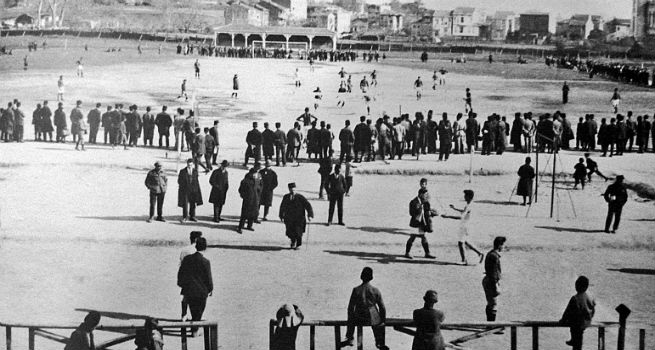 |
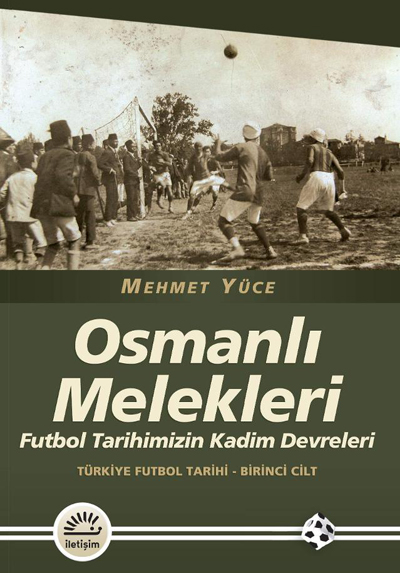 |

